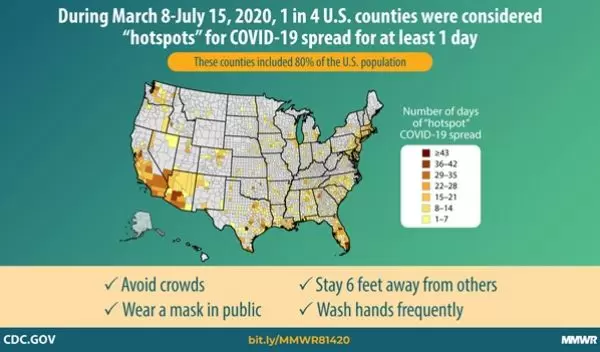
Researchers develop mathematical model to predict disease spread patterns
Early in the COVID-19 pandemic, health officials considered contact tracing the most effective way to anticipate the virus's migration from initial, densely populated hot spots to new locations. Months later, infections were being recorded in similar patterns in nearly every region of the country, both urban and rural.
Alerted by the unusual wealth of data regularly published throughout the pandemic by county health agencies, a team of environmental engineers began researching new methods to describe what was happening without needing to obtain information on individuals' movements or contacts. The project was funded by the U.S. National Science Foundation.
"This study offers an approach to help guide the management of the spread of COVID-19," said Bruce Hamilton, a program director in NSF's Directorate for Engineering.
In a paper published in the Proceedings of the National Academy of Sciences, the researchers present a model that predicts where disease will spread in an outbreak, in what patterns and how quickly.
"Our model should be helpful to policymakers because it predicts disease spread without getting into granular details, such as personal travel information, which can be tricky to obtain from a privacy standpoint and difficult to gather in terms of resources," said Xiaolong Geng, an environmental engineer at New Jersey Institute of Technology who built the model. and is one of the paper's authors.
"We did not think a high level of intrusion would work in the U.S., so we sought an alternative way to map the spread," said Gabriel Katul of Duke University, a co-author.
Their numerical scheme mapped the classic SIR epidemic model (computations based on susceptible, infectious and recovered people) onto a population cluster template. The calculations closely approximated the multiphase COVID-19 epidemics recorded in each U.S. state.
"Ultimately, we'd like to come up with a predictive model that would let us determine what the likely outcome would be if a state took a particular action," Katul said.
By plotting all the data published weekly by county health agencies, the researchers discovered that the disease spread across the country in similar patterns, from the largest cities to the tiniest hamlets. "High infection 'hotspots' interspersed in regions where infections remained sporadic were ubiquitous early in the outbreak, but the spatial signature of the infection evolved to affect most regions equally, albeit with distinct temporal patterns," the authors wrote.
When the alarm went out in March of last year, it was already too late, the scientists found. "While the superhighways of contagion -- air flights -- were curtailed, the disease spread at the local level from city to city," said Michel Boufadel, an environmental engineer at NJIT and corresponding author of the study. "Using the standard precautions of masking and distancing is not enough if there are a lot of people out there. There will still be superspreader events resulting from 5-10 people gathering."


